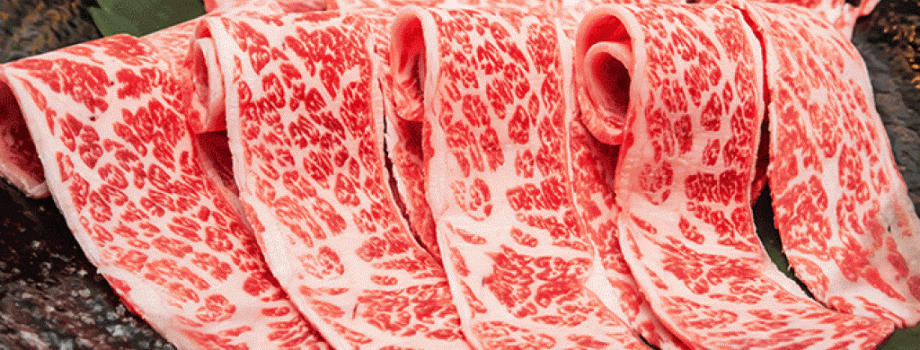Seeing the term Kobe beef on a menu stirs up lots of excitement, with the Japanese doing an excellent job at marketing the elusive meat. Kobe beef is like black gold caviar. Like aged Chateau Margaux wine. Like hand-rolled chocolate truffles. In other words, it’s expensive, highly sought after, and a status symbol.
Questions: What is it that makes Kobe beef so special and expensive?
Answer:
Kobe beef is a special grade of beef that comes from the Tajima-gyu breed of cattle found in Japan’s Hyogo Prefecture. Introduced as work animals in the rice cultivation industry during the 2nd Century, Tajima-gyu became isolated from other breeds, hiding away in Japan’s mountainous landscape in small pockets of cultivable land. This isolation is said to be responsible for a completely unique taste and texture; one that depicts Kobe beef as the ultimate meat when it comes to flavour, tenderness, and high amounts of intramuscular fat.
The story of Kobe beef
The legend surrounding Kobe beef has long been a source of fascination. Folklore tells of cows enjoying classical music, massages with sake and diets based on beer. Some legends are merely stories that have taken a life of their own, but these three examples are actually based on some truth.
- Classical music
It’s said that Tajima-gyu cattle benefit greatly from classical music, with it being common practice to have classical music played during feeding times. The music is played to the cows as a relaxation technique, and aims to connect eating with positive emotion, therefore increasing appetite.
- Massages with sake
Massages are common practice for these very special cows, largely because of limited space. When cattle are tied to one place for months, with little opportunity for exercise, massage is said to make the animal more comfortable and able to relieve stress due to stiffness resulting from inactivity. The sake is used to increase the softness of the skin and shine of the hair, which the Japanese believe is of economic importance and related to meat quality.
- Beer-based diet
Beer is fed to cattle during the summer months, when the interaction of fat cover, temperature, and humidity depresses food intake. Used as part of an overall management program, beer is said to stimulate appetite, encouraging cattle to eat when they normally wouldn’t.
This imagery, which depicts the cows living as kings in the Kobe region, adds to the decadence of a Kobe beef meal, and plays a part in its high cost. But not all Kobe beef is authentic.
Authenticity
To be authentic, Kobe beef must:
- Be of pure Tajima-gyu lineage,
- Have been born and raised in Hyogo Prefecture,
- Be a steer (castrated bull) or virgin cow,
- Be fed with only grains and grasses that come from within the Prefecture,
- Be processed in approved slaughterhouses within the Prefecture,
- Have a fat marbling ratio (BMS) of level 6 or above,
- Have a Meat Quality Score of A4 or A5 (top-grade),
- Have a gross carcass weight of less than 470kg, and
- Have its own assigned 10 digit ID number for its authenticity to be traced.
The reality is that restaurants all over the world are claiming to be using Kobe beef when, in fact, it’s highly unlikely. In Japan there are strict laws in place on the usage of the term Kobe beef, but such standards are largely unrecognised abroad. Restaurants can easily claim they’re using Kobe beef with very little backlash, and this isn’t just a shame for genuine producers but also for the people eating it. Trust us, when you eat Kobe beef you’ll know it!
Wagyu beef – What’s the difference?
Many restaurants use the term Wagyu as being synonymous with Kobe beef. Sure it’s connected, but it doesn’t mean the same. Wagyu simply means ‘Japanese cattle’, and despite what some restaurants may claim on their menus, it’s not a breed itself. Instead, it’s classified into four breeds:
- Japanese black,
- Japanese brown,
- Japanese poll, and
- Japanese shorthorn.
Tajima-gyu cows, from which Kobe beef comes, specifically belong to the Japanese black breed. While all Wagyu beef is considered high quality, only meat of the Tajima-gyu cow that fulfills the strict lineage and quality criteria can be called Kobe beef.
What can you expect from Kobe beef?
Kobe beef is prized for its flavour, marbling, and texture. It’s buttery, smooth, melt-in-your-mouth texture and qualities make it different to any other meat on Earth, and so rich it is that around a 100g portion would be plenty.
If you’re lucky enough to try authentic Kobe beef, you’re one of very few. Kobe beef makes up just 0.06% of all the beef consumed in Japan, and considering very little leaves the country, you can be assured that any overseas restaurant serving Kobe beef is pretty exclusive.
If you can’t make it to Japan, don’t worry. Wagyu beef – that’s any Japanese cattle – is delicious no matter the breed, so you certainly won’t regret trying it.
For Australians, there’s also hope with AACo’s Darling Downs Wagyu, bred on AACo’s Wylarah and Glentana Stations. Their cattle are fed for 500 days and so delicious is the meat that it’s picking up award after award, quickly becoming one of the most sought-after meats in the world. And it’s served in none other than Kobe Jones Melbourne.






 (11 votes, average: 4.36 out of 5)
(11 votes, average: 4.36 out of 5)